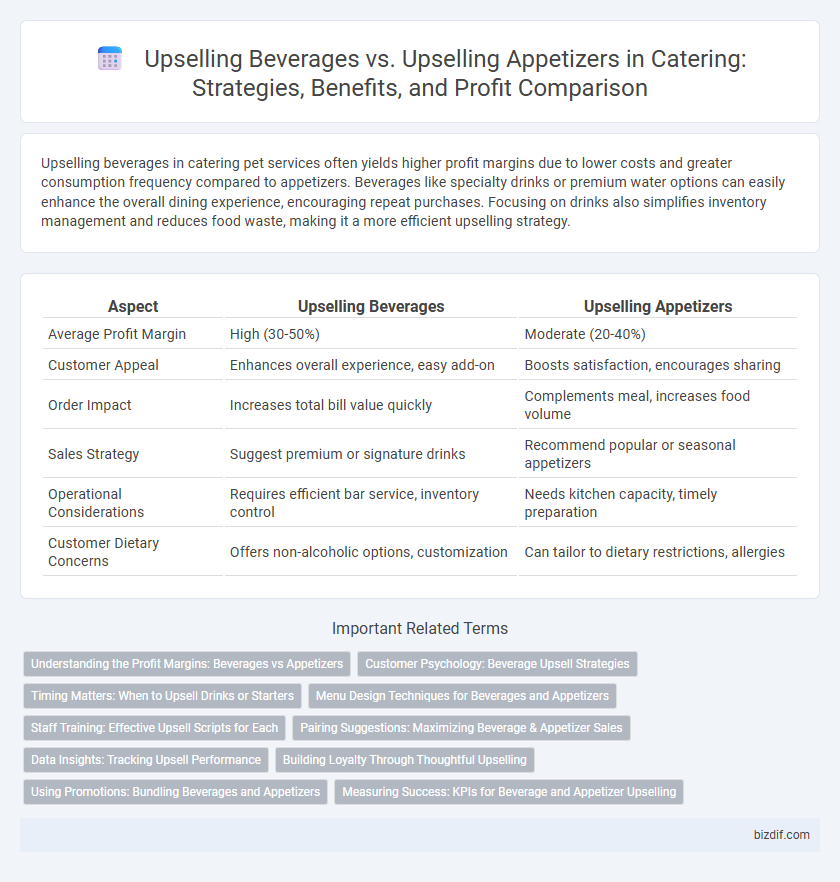Upselling beverages in catering pet services often yields higher profit margins due to lower costs and greater consumption frequency compared to appetizers. Beverages like specialty drinks or premium water options can easily enhance the overall dining experience, encouraging repeat purchases. Focusing on drinks also simplifies inventory management and reduces food waste, making it a more efficient upselling strategy.
Table of Comparison
| Aspect | Upselling Beverages | Upselling Appetizers |
|---|---|---|
| Average Profit Margin | High (30-50%) | Moderate (20-40%) |
| Customer Appeal | Enhances overall experience, easy add-on | Boosts satisfaction, encourages sharing |
| Order Impact | Increases total bill value quickly | Complements meal, increases food volume |
| Sales Strategy | Suggest premium or signature drinks | Recommend popular or seasonal appetizers |
| Operational Considerations | Requires efficient bar service, inventory control | Needs kitchen capacity, timely preparation |
| Customer Dietary Concerns | Offers non-alcoholic options, customization | Can tailor to dietary restrictions, allergies |
Understanding the Profit Margins: Beverages vs Appetizers
Beverages typically offer higher profit margins compared to appetizers due to lower ingredient and preparation costs, making upselling drinks a more lucrative strategy in catering. Appetizers, while potentially lower in margin, can increase overall guest satisfaction and lead to higher overall spend when combined with beverage sales. Understanding these profit differentials allows caterers to craft targeted upselling tactics that maximize revenue and enhance the event experience.
Customer Psychology: Beverage Upsell Strategies
Beverage upselling taps into customer psychology by leveraging the desire for sensory enhancement and social signaling, making drinks appear as an integral part of the dining experience rather than an extra cost. Offering personalized or visually appealing beverage options increases perceived value, prompting guests to indulge more easily compared to appetizers, which often require additional hunger appeal. Strategies such as suggesting premium pairings or limited-time specialty drinks exploit decision-making heuristics, encouraging higher spend through subtle social proof and scarcity cues.
Timing Matters: When to Upsell Drinks or Starters
Upselling beverages is most effective early in the dining experience, as customers are more likely to order drinks to complement their meal or while waiting for appetizers. Upselling appetizers works best soon after seating, capturing guests' initial hunger and setting a flavorful tone for the event. Strategic timing in beverage and appetizer upselling maximizes revenue by enhancing guest satisfaction and aligning offers with natural dining cues.
Menu Design Techniques for Beverages and Appetizers
Menu design techniques for upselling beverages emphasize strategic placement of premium drinks in high-visibility areas and descriptive, sensory-rich language to entice customers. For appetizers, highlighting unique ingredients and pairing suggestions can stimulate interest and increase orders by appealing to taste and experience. Leveraging hierarchy, color contrast, and suggestive prompts enhances the effectiveness of upselling both beverages and appetizers on catering menus.
Staff Training: Effective Upsell Scripts for Each
Staff training in catering emphasizes tailored upsell scripts to maximize revenue; beverage upselling relies on highlighting premium drink features and pairing suggestions, while appetizer upselling focuses on taste appeal and portion convenience. Well-crafted scripts empower staff to confidently recommend options that enhance the overall guest experience, driving higher average order values. Consistent role-playing and feedback sessions refine staff delivery, ensuring persuasive and natural interactions tailored to each upsell category.
Pairing Suggestions: Maximizing Beverage & Appetizer Sales
Pairing suggestions enhance upselling by matching beverages with complementary appetizers, increasing overall sales in catering. Offering wine or craft cocktails that highlight appetizer flavors encourages customers to purchase both, boosting revenue per order. Leveraging flavor profiles and seasonal ingredients optimizes guest satisfaction and maximizes beverage and appetizer sales simultaneously.
Data Insights: Tracking Upsell Performance
Tracking upsell performance reveals beverages achieve 25% higher conversion rates compared to appetizers in catering services. Data insights show beverages generate 30% greater revenue per upsell opportunity, driven by higher customer willingness to spend on drinks. Analytics tools help identify peak times and popular items, optimizing strategies to maximize profits from beverage upselling.
Building Loyalty Through Thoughtful Upselling
Upselling beverages in catering encourages repeat business by offering curated drink pairings that enhance the overall dining experience, fostering customer satisfaction and loyalty. Thoughtful upselling of appetizers targets guest preferences and introduces unique flavors, creating memorable moments that build trust and long-term relationships. Prioritizing personalized recommendations in beverage and appetizer upselling increases perceived value and reinforces brand loyalty among catering clients.
Using Promotions: Bundling Beverages and Appetizers
Bundling beverages and appetizers in catering promotions enhances upselling opportunities by creating value-driven packages that encourage customers to purchase more. This strategy increases average order size while offering a seamless customer experience, leveraging the natural pairing of drinks and snacks. Data shows that bundled promotions can boost sales by up to 20%, making them more effective than upselling beverages or appetizers individually.
Measuring Success: KPIs for Beverage and Appetizer Upselling
Key performance indicators (KPIs) for upselling beverages focus on metrics such as average beverage revenue per guest, drink attachment rate, and upsell conversion percentage, highlighting customer inclination towards premium or specialty drinks. For appetizers, KPIs include appetizer attach rate, incremental appetizer sales, and average appetizer spend per order, emphasizing the effectiveness of promoting starters that complement main courses. Monitoring these KPIs allows catering managers to identify high-impact opportunities and optimize upselling strategies for both beverage and appetizer categories.
Upselling beverages vs upselling appetizers Infographic

 bizdif.com
bizdif.com